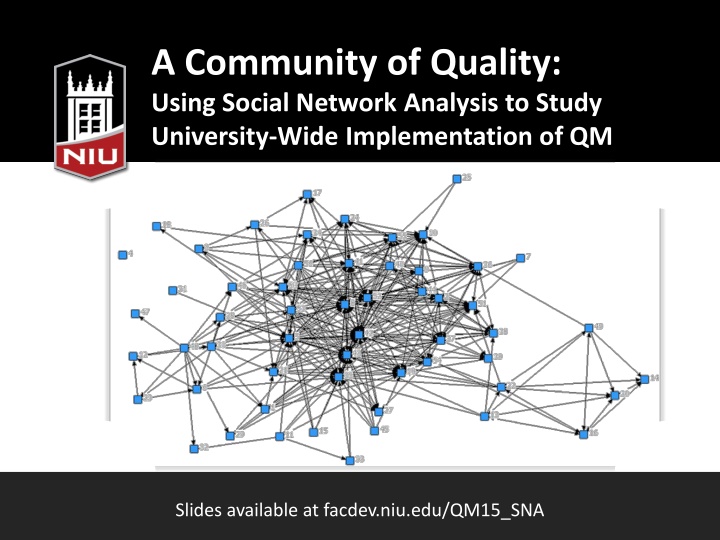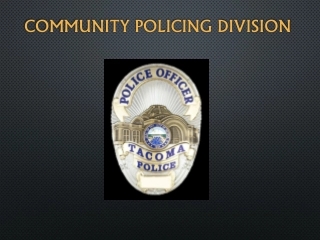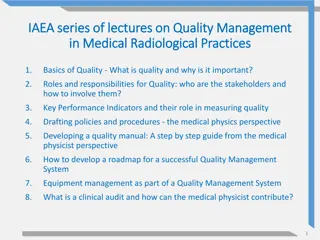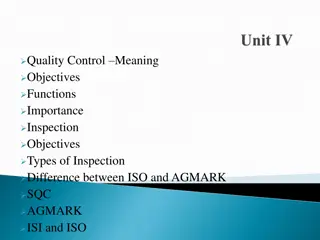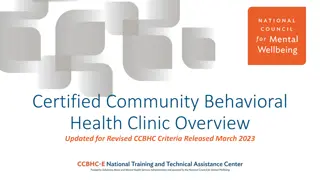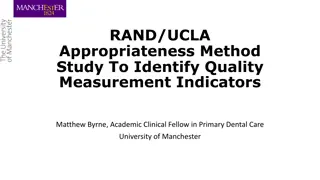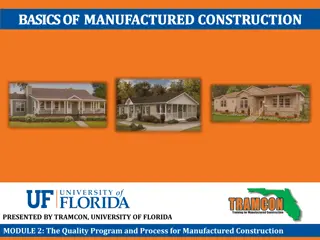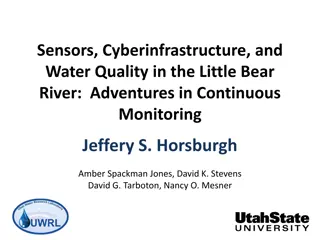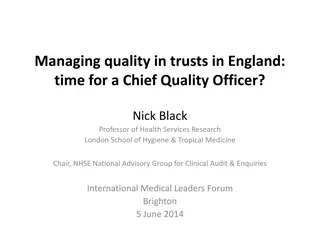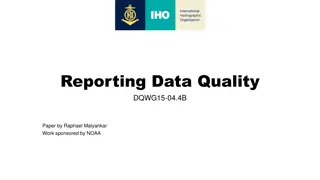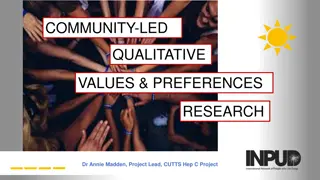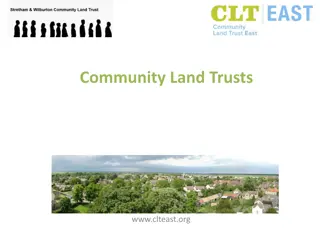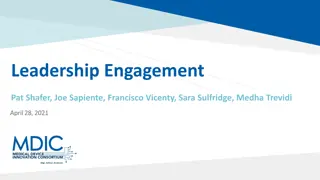A Community of Quality
How Social Network Analysis is used to study the implementation of Quality Matters university-wide. Discover key brokers and increase connections within communities using SNA protocols. Engage in interactive activities to evaluate community formation and enhance online teaching quality standards at NIU.
Download Presentation

Please find below an Image/Link to download the presentation.
The content on the website is provided AS IS for your information and personal use only. It may not be sold, licensed, or shared on other websites without obtaining consent from the author.If you encounter any issues during the download, it is possible that the publisher has removed the file from their server.
You are allowed to download the files provided on this website for personal or commercial use, subject to the condition that they are used lawfully. All files are the property of their respective owners.
The content on the website is provided AS IS for your information and personal use only. It may not be sold, licensed, or shared on other websites without obtaining consent from the author.
E N D
Presentation Transcript
A Community of Quality: Using Social Network Analysis to Study University-Wide Implementation of QM Slides available at facdev.niu.edu/QM15_SNA
Presenters John Cowan Sr. Research Associate Outreach jcowan@niu.edu Aline Click Director eLearning Services aclick@niu.edu Tracy Miller Stephanie Richter Assistant Director Faculty Development srichter@niu.edu Online Teaching Coordinator Faculty Development tracy.miller@niu.edu
Session Objective Define social network analysis and describe its use in studying community formation Describe a SNA protocol used to identify key brokers and increase connection within a community
Activity Write your name on a post-it note Choose size based on your experience with QM Small: 0-2 years Medium: 3-5 years Large: 6+ years Choose color based on your institution Blue: 4-year, higher ed Yellow: 2-year, higher ed Green: K-12 Pink: Corporate
Activity Post your name on the poster Public Private
Activity Add your connections During our presentation, pass the markers around to add lines to connect yourself with anyone you know and consider a colleague
Our Community: Faculty and Staff Working with Online Teaching Quality Standards at NIU
QM at NIU Adopted September, 2014 Review is optional but encouraged (and required for courses or programs to be promoted) Standards are automatically incorporated in courses developed by eLearning Services
Community of Inquiry Adopted CoI framework to address siloing and increase sense of ownership for faculty Sample Activities: Campfires in Cyberspace Informal presentations & discussion within departments Online Course Design Academy Problem: How to evaluate community formation?
What is Social Network Analysis? A systematic method for capturing relationships in a group Allows visual representation of quantitative data using lines (connections) and dots (nodes)
SNA as Research Methodology A mixed methods approach (an ethnographic sandwich) Started in the 1930 s (Moreno, 1934) 1970s present - Advancements with technology and fusion between matrix algebra and graph theory and the social sciences allows network measurements (White, Boorman & Breiger, 1976)
An Ethnographic Sandwich Initial Contact Social Network Analysis Review/Member Checking (Halgin & DeJordy, 2008)
Common SNA Statistical Measures How central an actor is in a network Centrality The degree to which an actor is located between others on pathways in a network Betweeness The ratio of connections in a network to the total number of possible connections Density Smaller complete subgroups that exist within a larger network Cliques The distance from one actor to another in a network Distance Geodesic Distance The number of relations in the shortest possible walk from one actor to another actor Homophily The tendency of members of a network to cluster with other members who share similar characteristics (Hanneman & Riddle, 2005)
Quality Matters at NIU: Social Network Analysis
Network Overview Initial network data gathered at 2014/2015 APPQMR Sessions Initial network data included three elements: - Who have you worked with to develop online content prior to APPQMR? - Who have you worked with on Quality Matters prior to APPQMR? - Who would you seek advice from? 56 total participants (nodes)
Quantitative Statistics Whole Network Centrality Measures Current Measure Number of lines in a graph, expressed as a proportion of the maximum possible number of lines. Density 0.136 Degree Number of links per person. 7.464 Number of connections in the shortest possible walk from one actor to another. Distance 1.965 Portions of the network that are disconnected from each other. Components 25 Percentage of the network that is disconnected (areas where network connections are absent). Fragmentation 0.558 Number of subgroups wherein all members are connected to each other. Cliques 23
The Initial NIU QM Network: Three Component Composite Image Numbers = Participant ID
Who have you worked with to develop online content prior to APPQMR? Numbers = Participant ID
Who have you worked with on Quality Matters prior to APPQMR? Numbers = Participant ID
Who would you seek advice from? Numbers = Participant ID
Composite Network: Members Roles Numbers = Role 1 = Professor 4 = Graphic Artist 7 = Web Developer 10 = Analyst 13 = Dean 16 = QM FacDev Advisor 2 = Instructional Designer 5 = Coordinator 8 = Chair 11 = NA 14 = Other 17 = QM Outreach Advisor 3 = Researcher 6 = Director 9 = Support Staff 12 = Instructor 15 = QM eLearning Advisor 18 = Non- Respondent
Composite Network: Members Location Numbers = Role Shape = Locations eLearning College of Education College of Business Other College of Health and Human Sciences Faculty Development College of Liberal Arts and Sciences Outreach College of Visual and Performing Arts Office of Assessment
Composite Network: Members Power Numbers = Role Shape = Locations Size = Power Power = A combination of rank, tech skill self-rating and experience (online teaching and developing content) The larger the shape, the greater the power rating
Interest in QM Reviewer Training Numbers = Role Shape = Locations Size = Power Color = Interest Need More Information Not Interested or Not Able Interested and Able
Next Steps Continue gathering initial data for new entrants to the network Identify actions to take based on individual nodes in the network Provide opportunities for networking and community growth Conduct a follow-up survey to get new data after 6-12 months
Desired Results Current Measure Future Analysis Positive Indicator Centrality Measures Density 0.136 Degree 7.464 Distance 1.965 Components 25 Fragmentation 0.558 Cliques 23
References and Resources Analytic Technologies (2015). Social Network Analysis Software Cultural Domain Analysis Software. Retrieved from: http://www.analytictech.com/. DeJordy, R. and Halgin, D. (2008). Introduction to ego network analysis. Retrieved from: http://www.analytictech.com/e net/PDWHandout.pdf. Hanneman, Robert A. and Mark Riddle. 2005. Introduction to social network methods. Riverside, CA: University of California, Riverside. Retrieved http://faculty.ucr.edu/~hanneman/. Moreno, J.L. (1934). Who Shall Survive? Washington, DC: Nervous and Mental Disease Publishing Company. White, H. C., Boorman, S. C., & Breiger, R. L. (1976). Social structures from multiple networks, I: Blockmodels of roles and positions. American Journal of Sociology, 81, 730-780.
Questions? John Cowan Sr. Research Associate Outreach jcowan@niu.edu Aline Click Director eLearning Services aclick@niu.edu Tracy Miller Stephanie Richter Assistant Director Faculty Development srichter@niu.edu Online Teaching Coordinator Faculty Development tracy.miller@niu.edu Slides available at facdev.niu.edu/QM15_SNA
